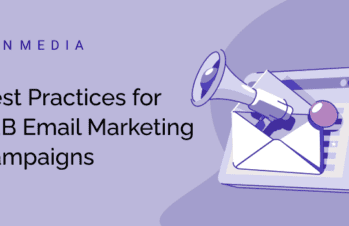People still need to check their emails, regardless of age, occupation, or digital preferences. In fact, 77% of marketers have seen an increase in email engagement over the last 12 months.
But having email lists comes with great responsibility. Inundating subscribers results in irritated recipients who eventually unsubscribe. Rather than come across as a nuisance, you can become a constant email address that people look forward to in their inbox. Whether for a monthly update, newsletter, or other form of content, email holds great potential.
To maximize this potential, you should be wary of these 17 email marketing mistakes we’re still seeing:
1. Overwhelming Frequency
Your subscribers were interested in your offering. Now you have their email address. See it as gold. Showing up in someone’s inbox is a prime way to stay top of mind, but make sure that what you send is thoughtful and adds value to the customer.
We often see companies launching campaigns that simply have too many touchpoints. Constant inundation is a poor way to compel prospective buyers to take action. Rather than overload subscribers, provide them with valuable content and offerings in a condensed, straightforward way. If you’re sending emails every few days, you will see your unsubscribe rate hike up. This will be harmful to your organization in the long run and will flag the sender email address as spam.
2. Poor Timing
You’ve heard the old adage: timing is everything. Be mindful of your target audience and their lifestyles. If your target audience are parents, don’t send emails while they’re dropping their children off at school. There are routines that shape people’s lives, and your email strategy should be mindful of that. No one clicks a newsletter on a Friday afternoon. And if you send at an inopportune time, you are setting your organization up for failure.
Your team poured time into a thoughtful email. It would be a shame for it to get buried under weekend updates and promotions. When it comes to email, you basically have one chance. Know the best time to catch your audience’s attention, like on a Tuesday around lunchtime, when someone is in a focused mood and has a few moments to browse.
3. Lack of Personalization
“Hi there” is a lousy way to start a conversation.
Marketing automation is too sophisticated to not take advantage of. With tools like HubSpot, there are an abundance of built in—and customizable—personalization tokens. Leverage the data that you have spent great time and resources collecting. Segmentation will help to hone in on audiences and what is important to them. Use the data that you have to segment your audiences and personalize based on industry, spending, and stage in the buyer’s journey.
4. Ignoring Mobile Optimization
People aren’t only checking emails from a laptop or computer. During the work day, people likely have at least two screens around them, one of which is mobile.
You could write the most strategic, effective email in the world but if you’re working with a tiny light font that is painful to consume on a mobile device, it will not have the impact that you worked for. This is frustrating for users who want to read the email you sent but need to zoom in to read the font.
5. Missing or Confusing Call-To-Action
Failing to have a clear and compelling CTA can confuse the reader. We’ve seen companies try to get inventive with the language used for the CTA, but most of the time readers are not able to properly process a funky CTA.
Opt for something straightforward, like “request more information,” or “learn more” to capture prospects that would benefit from your offering. Be aware of where the CTA is placed in the email as well by employing UI/UX best practices. Without a clear CTA, you risk your target audience not taking action, and passively awaiting a prompt that might never come.
6. Sending Without Testing
Testing is an imperative part of the email process. Test emails let you catch small errors that you perhaps overlooked while writing the original email copy. It helps to have a few people receive a test email. Because we all receive so many emails and notifications throughout the day, we can sometimes be insensitive to errors. That said, when they do arise, they’re all too clearly a sign of slight negligence. Avoid this flop by testing emails for spelling, links, and load time. In the age of many email tools and the ability to test, having something less than clean will come across as unprofessional and thoughtless.
7. Neglecting Metrics
It’s obvious, but metrics exist for a reason. They allow marketers to drill down on what is working and what is not. Buyer behavior can be carefully examined through the metrics provided through various email platforms. Open rates, click through rates, unsubscribe rates, and heat maps are an email marketers best friend. Sure, it can be a bit overwhelming, but it is also a huge opportunity to constantly perfect the email. Pivot continuously and test what works and what does not. Pay attention to these metrics over time to identify trends, take action, and watch your metrics improve over time.
8. Buying Email Lists
Purchasing email lists is just not a good practice. It leads to low engagement and can tarnish your brand’s reputation.
It is not great for business either, because email should serve as a sales and marketing tool. If you are selling and marketing to an audience that is presumably not interested in your services, you are effectively screaming into the void.
Additionally, there are growing privacy protection matters that can get your company into trouble if you market to lists who did not opt into your marketing communications. It’s better to have a small list of high-quality prospects and customers than a massive list of uninterested parties who will report emails as spam and hurt your reputation.
9. Forgetting About GDPR and Other Regulations
Failing to adhere to email regulations can lead to legal ramifications. As mentioned above, privacy is a growing issue. It’s important to honor people’s wishes regarding their correspondence preferences.
10. No Unsubscribe Option
There needs to be an easy way for people to unsubscribe from your email list. Ideally the button or link will be at the top or bottom of a standard email, showing that there is a level of transparency and trust that your organization is willing to show. Buyers know that they always have the option to opt out, and providing this choice is essential to building trust. Include an unsubscribe link; otherwise you risk a negative brand sentiment and potential spam reports.
11. Ignoring A/B testing
A/B testing is another one of those features that you should absolutely employ to optimize your email strategy. Creating A/B versions of campaigns allows you to control the email with metrics that will meet your KPIs and lead to the business that you want. A/B testing lets you measure your subscribers’ experience and continually optimize.
12. Generic Subject Lines
Subject lines that grab the attention of your readers are critical to success. Showcase your brand’s personality and ability to proliferate a succinct message in a subject line. With ChatGPT, subject line testers and generators, you can surely create a subject line that will intrigue your readers.
Even cold emails can have a fun subject line, for instance, one of our content strategists at Zen was in freezing weather and wrote “I’m in Minnesota, and I’m as cold as this email.” It got loads of responses because it was kitschy and inventive. Don’t be afraid to play around here, but of course, don’t offend anyone.
13. Not Cleaning the Email List
Clean your email list to remove inactive or bounded email addresses. You want to have a high delivery rate and high open rate. If you’re sending to dead email addresses, there is no way that you can achieve the metrics that will lead to success. Make a habit of parsing your email list at least once a month. This used to be a horribly manual process. Now it’s supercharged thanks to marketing automation and AI tools that detect the fat you need to trim from your list.
14. Sending Without Purpose
As John Mayer sings, “Say what you need to say.” But there’s no reason to say something when you don’t need to say it. Basically, don’t send an email just for the sake of it. If it does not serve a purpose in informing, educating, or adding value to your buyers, don’t send it. Ask yourself and your team, “Do our buyers care about this?”
15. Using Heavy Images and Media
Use media that complements your written message. Beware of large files that increase load time. If the email does not load in a split second, people might realistically delete it before they read the first word. The media in the email should add to your message. Employ graphics, graphs, and memes that resonate with your audience. Whether actionable, informative, or funny, make sure it doesn’t weigh down the email and make your message obsolete.
16. Ignoring Feedback
Subscriber feedback is something that you should cherish, seriously. Sometimes it’s so hard to get people to engage, so when they do, take their feedback with stride. Showing that you pay attention to feedback reveals your commitment to your audience. You need to value those who are spending time with your content, and continually base your content on how they perceive what you send. If there’s no way to solicit feedback, people will become frustrated. There’s nothing worse than a “no reply” email address when you want to actually reply!
17. Avoiding Automation
Automation exists, so use it! Especially when you have a growing list and multiple campaigns running at once, automation will be a tremendous help. Whether it’s for a customer anniversary, check-in that was mentioned months prior, or someone’s birthday, use personalization tokens and scheduling tools to automate messages. This shows a high level of personalization and sophistication, making your brand look professional and helping your customers feel seen.
Digital marketing is as much an art as it is a science, and it’s critical to pay attention to trends, attitudes, and temperatures to stay on top of best practices. Remember, everyone checks their email—so rather than being an irritating sender, perfect being something that they look forward to in their inbox.
Want to learn how to perfect your brand’s email marketing strategy? Reach out.





